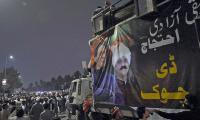The final reforms package of the Parliamentary Committee on Electoral Reforms has been stalled, reportedly due to a deadlock among the deliberating parties over the use of Electronic Voting Machines (EVMs) and biometric systems in the general election of 2018.
Representatives of some political parties, particularly the PTI, have taken a firm position on the introduction of this technology in the next general election as a prerequisite for fairness. These parties are perhaps compelled to recommend ‘fool-proof technological measures’ against the backdrop of illegal practices that have marred the credibility of the previous elections. It sounds logical, but the proponents of technology need to realise that the issue is not the absence of legal controls but their enforcement.
The voting process used in Pakistan is transparent and effective, if implemented in the way it is prescribed in Section 33 of the Representation of the People Act, 1976. A voter is issued a ballot paper after multiple checks, ascertainment by the polling officer that the person is registered on the electoral list and the endorsement of the polling agents of all contesting candidates that the person is not impersonating another voter.
The legal requirement for voters to carry their original CNIC has also made the system fool-proof. Voters’ credentials, including CNIC number and thumb impression, are documented on the counterfoils of the ballot book for future verification. Each counterfoil and ballot paper is signed and stamped by assistant presiding officers to ensure that fake ballots, if any, are not counted after the polls close. If this well-defined process can be tampered with, technology can also be misused. The problem is with the regulators, not the process.
2018 is too early to replace the existing paper ballot system with electronic voting machines, when it took our neighbour India more than 15 years for a complete transformation. The examples of other countries doing away with EVMs and going back to the paper ballot need to be carefully studied. Some of these states scrapped EVMs because of issues with the secrecy of the vote, and others thought they were not transparent.
While these issues merit consideration from the proponents of technology, the cost should be one of the major determinants of any decision. If this is not a billion dollar proposition, it is certainly close to it. Let’s try to contextualise EVMs for Pakistan, using the general election of 2013 as an example. The ECP established 69,801 polling stations and 193,459 polling booths. Since the country holds concurrent elections for the national and provincial assemblies, each booth must have at least two EVMs: one for the national elections and the other for the provincial elections. Simple arithmetic leads to a total of 386,918 machines (193,459 booths, with one machine for the national and one for the provincial assembly election).
This is the minimum number of machines that the country needs to conduct the election. But the actual number of machines depends on the type of the machines used. The machines used in India may be taken as an example because they function in a context more or less similar to that of Pakistan. The Indian EVM comprises a control unit, a ballot unit, a battery and a five-meter cable to connect the control unit to the ballot unit. The control unit remains with the presiding officer and the ballot unit is placed behind the secrecy screen. Instead of issuing a ballot paper, the presiding officer presses the ballot button on the control unit, enabling the voter to cast his or her vote by pressing the blue button on the ballot unit, representing the candidate of his or her choice. The machine locks itself after the voter presses a blue button, ensuring that one voter can cast only one vote.
While the control unit can cater to 64 candidates, the ballot unit can accommodate only 16 candidates. If the total number of candidates exceeds 16, a second ballot unit needs to be linked to the first ballot unit. If the total number of candidates exceeds 32, a third ballot unit is attached. And if the total number of candidates exceeds 48, a fourth ballot unit is attached.
Applying this to the Pakistani context, there were 4,671 candidates in the run for the National Assembly and 10,958 candidates for provincial assembly seats in 2013. On the basis of these figures, Pakistan would have needed 386,918 control units and 584,030 ballot units for the general election of 2013. According to ECP officials, an Indian EVM costs around $600. Using this base price, the cost can safely be projected to around Rs35 billion, including costs for extra ballot units and batteries. This cost will only increase for the 2018 elections, considering that the ECP is planning to increase the number of polling stations.
Future costs to be incurred on the storage, repair and maintenance of these machines also need to be factored in. A price tag is also attached to the training of more than 600,000 personnel deployed for election day duties. Additionally, a one-time cost will have to be incurred for the acquisition of a temperature-controlled space for the storage of these machines, as the ECP does not have its own offices in most of the districts. The government will have to either provide the ECP with land and funds to build its offices at the district level, or arrange for the adequate storage for these machines.
The long- and short-term costs certainly outweigh the benefits, if any, of this technology. There are no qualms about the use of technology to improve the efficiency of the electoral processes, but the technology should be appropriate, effective and affordable.
Some appropriate and cost effective technological solutions include: (i) a web-based results management system; (ii) ballot papers watermarked for each constituency; (iii) GIS enabled polling schemes; (iv) optimal use of the ECP website to provide information to voters and candidates; (v) the public release of election result forms before the gazette notification of the winners; (vi) voter registration information via SMS; (vii) voter education via SMS; and (viii) voter support helplines. However, the focus should be on strengthening the electoral process and controls, not on ignoring existing weaknesses and using inappropriate technology.
The writer works with the Free and Fair Election Network (Fafen).
Email: mud.rizvi@tdea.pk
Data, today, defines how we make decisions with tools allowing us to analyse experience more precisely
But if history has shown us anything, it is that rivals can eventually unite when stakes are high enough
Imagine a classroom where students are encouraged to question, and think deeply
Pakistan’s wheat farmers face unusually large pitfalls highlighting root cause of downward slide in agriculture
In agriculture, Pakistan moved up from 48th rank in year 2000 to an impressive ranking of 15th by year 2023
Born in Allahabad in 1943, Saeeda Gazdar migrated to Pakistan after Partition







